![]()
![]()
![]()
Use LEFT and RIGHT arrow keys to navigate between flashcards;
Use UP and DOWN arrow keys to flip the card;
H to show hint;
A reads text to speech;
32 Cards in this Set
- Front
- Back
- 3rd side (hint)
|
How many hypothalamic hormones? |
8 + total. 6 regulate the anterior pituitary. Two are released into capillaries in the posterior pituitary. |
|
|
|
Thyrotropin releasing hormone TRH |
Promotes anterior pituitary secretion of thyroid stimulating hormone (TSH) |
|
|
|
Corticotropin-releasing hormone (CRH) |
Promotes anterior pituitary secretion of adrenocorticotropic hormone (ACTH) |
|
|
|
Gonadotropin releasing hormone (GnRH) |
Promotes anterior pituitary secretion of follicle-stimulating hormone and luteinizing hormone. (FSH & LH) |
|
|
|
Growth hormone releasing hormone (GHRH) |
Promotes anterior pituitary secretion of growth hormone (GH) |
|
|
|
Prolactin inhibiting hormone (PIH) |
Inhibits secretion of prolactin |
|
|
|
Somatostatin |
Inhibits secretion of growth hormone and thyroid stimulating hormone by the anterior pituitary. (GH & TSH) |
|
|
|
2 hypothalamic hormones are released into the capillaries of the posterior pituitary where they are stored and released but not synthesized |
Oxytocin and antidiuretic hormone (OT & ADH) |
|
|
|
How many hormones does the anterior lobe of the pituitary synthesize and secrete? |
6 |
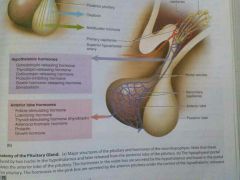
|
|
|
Thyroid stimulating hormone |
Secreted by anterior pituitary. Stimulates secretion of thyroid hormone |
|
|
|
Adrenocorticotropic hormone (ACTH) |
Secreted by anterior pituitary. Stimulates the adrenal cortex to secrete glucocorticoids |
|
|
|
Prolactin (PRL) |
Secreted by anterior pituitary. After birth stimulates mammary glands to synthesize milk |
|
|
|
Growth hormone |
Secreted by anterior pituitary. Stimulates mitosis and cellular differentiation |
|
|
|
Gonadotropin hormones secreted by the anterior pituitary |
Follicle-stimulating hormone (FSH) stimulates secretion of ovarian sex hormones, development of ovarian follicles and sperm production. Luteinizing hormone (LH) stimulates ovulation, stimulates corpus luteum to secrete progesterone. Stimulates testes to secrete testosterone. |
|
|
|
Posterior pituitary hormones. Two hormones produced in hypothalamus and transported to the posterior lobe of pituitary to be released and stored. |
Antidiuretic hormone(ADH) increases water retention reducing urine volume. Oxytocin (OT)hormone released during sexual arousal orgasm stimulates labor contractions during childbirth stimulates flow of milk during lactation. |
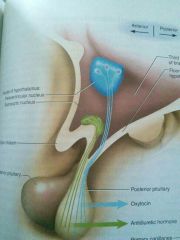
|
|
|
Pineal gland. Named for pine cone shape. |
Shrinks by the end of puberty. Plays a role in circadian rhythm. Synthesizes melatonin. Linked to seasonal affective disorder. |
|
|
|
Thymus plays a role in the endocrine, lymphatic, and immune systems. Bi lobed gland in the mediastinum superior to the heart. |
Shrinks after puberty. Site of maturation of T cells. Secretes hormones thymopoietin, Thymosin, thymulin |

|
|
|
Thyroid gland. Largest gland that is purely endocrine. Butterfly-shaped, wrapped around the larynx. |
Secretes thyroxine (T4) and triiodothyronine (T3) which together make thyroid hormone. Secreted in response to thyroid stimulating hormone by anterior pituitary. Primary effect increases metabolic rate. Parafollicular cells secrete calcitonin with rising blood calcium, stimulate osteoblast activity and Bone formation in children. |

|
|
|
Parathyroid glands. Four glands on posterior surface of thyroid gland. |
Secrete parathyroid hormone, increase blood calcium levels by stimulating calcium reabsorption from the bones. |
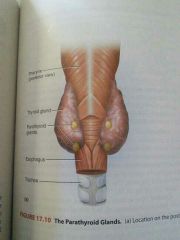
|
|
|
Thyroid disorders |
Endemic goiter disease is geographically localized, dietary iodine deficiency. Gland cannot synthesize thyroid hormone no feedback means increase thyroid stimulating hormone |
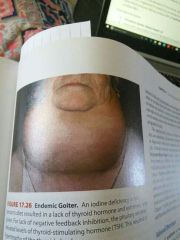
|
|
|
The adrenal glands. Small glands that sit on top of each kidney. Comprised of two parts: |
Adrenal cortex , Adrenal medulla |

|
|
|
Adrenal medulla |
Inner core of adrenal gland. Has dual nature as endocrine gland and ganglion of the sympathetic nervous system. Releases catecholamines epinephrine and norepinephrine and dopamine into the bloodstream. Increase alertness prepares body for physical activity increases blood pressure, decreases digestion and urine production |
|
|
|
Adrenal cortex |
Outer part of the adrenal glands surrounding medulla. Secretes several corticosteroids from three layers of glandular tissue. Mineralocorticoids regulate the electrolyte balance. Aldosterone stimulates sodium and potassium excretion. Glucocorticoids regulate metabolism of glucose and other fuel and help body adapt to stress and repair tissue. Cortisol and corticosterone stimulate fat and protein catabolism and gluconeogenesis. Sex steroids called androgens set libido and play a large role in prenatal male development. Estradiol in small quantities from adrenal becomes important after menopause for sustaining adult bone mass. |
|
|
|
Adrenal disorders |
Cushing syndrome excess cortisol secretion, hyperglycemic, hypertension, weakness, edema, rapid muscle and bone loss due to protein catabolism, abnormal fat deposition moon face and hump on back. |
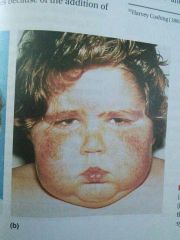
|
|
|
The pancreas is an elongated gland below and behind the stomach. Contains one to two million pancreatic islets. |
Islets are clusters of Endocrine cells that secrete hormones that regulate glycemia. Glucagon is secreted by alpha cells between meals when blood glucose concentration is falling. Glucagon stimulates the liver to release glucose raising the blood glucose level. Glucagon stimulates fat catabolism and release of free fatty acids within adipose tissue. Insulin is secreted by beta cells during and after a meal when glucose and amino acid levels are rising. Stimulates cells to absorb nutrients lowering blood glucose levels. |

|
|
|
Type 1 diabetes mellitus |
5 to 10% of diabetics in the US. Insulin secreted by beta cells insufficiency or in action of insulin. Hereditary susceptibility. Auto antibodies attach and Destroy pancreatic beta-cells. |
|
|
|
Type 2 diabetes mellitus |
90 to 95% of diabetics. Insulin resistance failure of target cells to respond to insulin. Risk factors are heredity, ethnicity, age, and obesity. Treated with weight loss and exercise |
|
|
|
Ovaries and testes are both endocrine and exocrine. |
Exocrine product is whole cells including eggs and sperm. Endocrine product gonadal hormones, mostly steroids. |
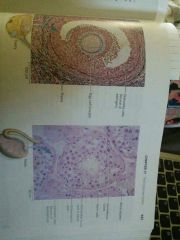
|
|
|
Ovarian hormones |
Estradiol and progesterone development of female reproductive system. Regulate menstrual cycle and sustain pregnancy. Prepare mammary glands for lactation. Inhibin suppresses follicle-stimulating hormone secretion from anterior pituitary. |
|
|
|
Testicular hormones |
Testosterone and weaker androgens and estrogen from interstitial cells between the seminiferous tubules. Stimulates development of male reproductive system and sex-drive sustained sperm production. Inhibin from sustenacular are cells limits follicle-stimulating hormone secretion in order to regulate sperm production. |
|
|
|
Liver. |
Involved in the production of at least five hormones. Secretes angiotensinogen precursor of Angiotensin II a regulator of blood pressure. Secretes 15% of erythropoietin which stimulates bone marrow. |
|
|
|
Kidneys |
Play a role in production of three hormones. Secrete renin that converts angiotensinogen to Angiotensin 1. Kidneys produce 85% of erythropoietin which stimulates bone marrow to produce red blood cells. |
|

